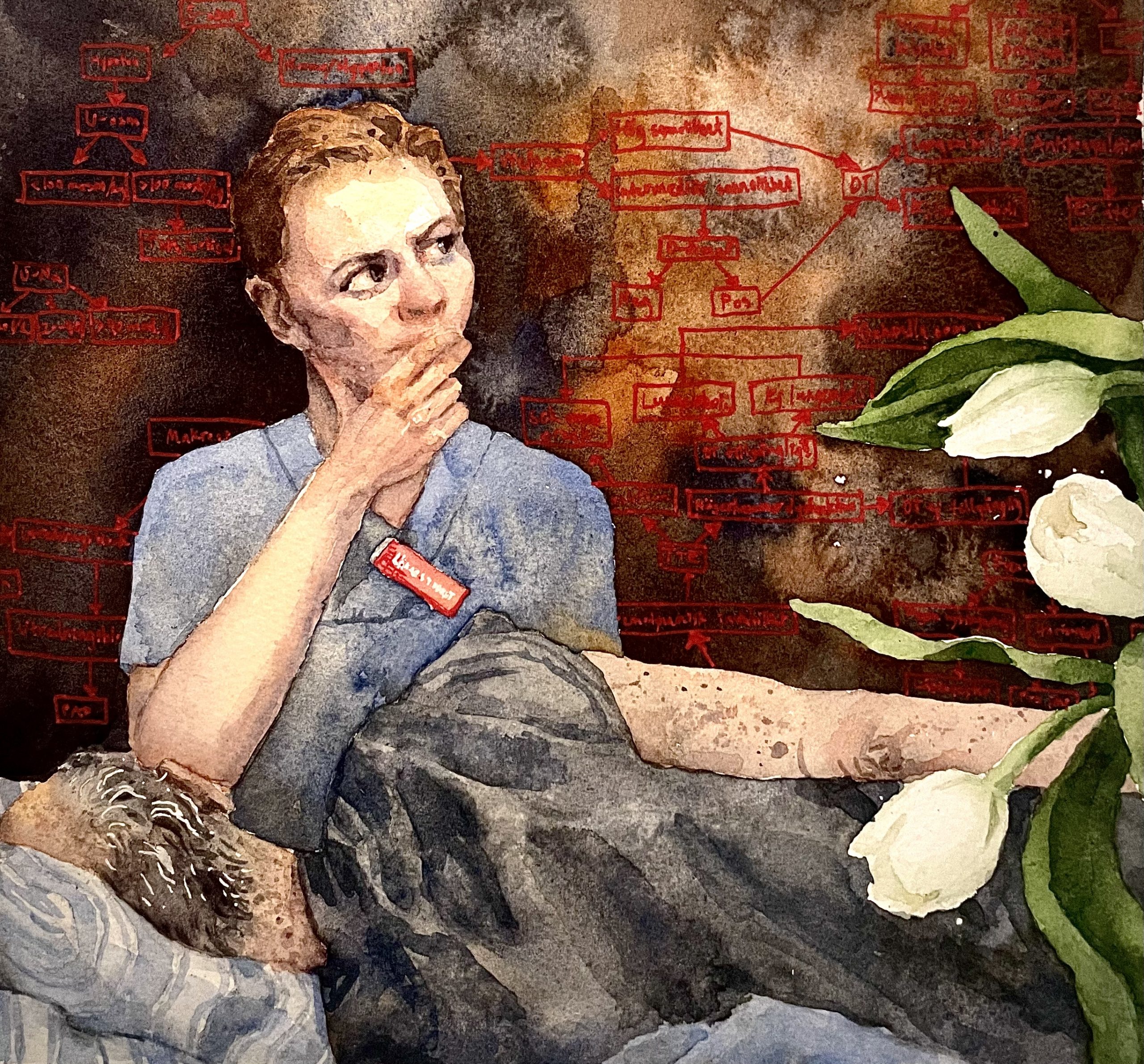
COLUMN. The brain’s two hemispheres specialize in different tasks but need each other’s assistance to fulfill their missions. Inspired by a worried medical student, Henrik Sjövall takes cues from the book “The Master and His Emissary” and reflects on the extent to which the brain’s own division of labor leaves an imprint on our student education.
When we learn about the brain’s anatomy, we learn very little about what is actually the largest part: our frontal lobes. In certain textbooks, they are treated as some sort of “think-tank”. We learn that someone who gets a tumor, hemorrhage, or other injuries in the frontal lobe may not necessarily experience paralysis but might just start behaving strangely, which might prompt worried relatives to send them to the ER or a primary care center. This often happens later than if there were obvious symptoms to the outside world, such as paralysis or sensory disturbance.

The frontal brain is described in textbooks as mainly symmetrical, and I had no idea that there were important side differences regarding its more complex tasks. Therefore, I was pleasantly surprised when I was tipped off about a book, “The Master and the Emissary,” which deals with precisely this. The author, Iain McGilChrist, was originally a literary scholar, then trained as a medical doctor and psychiatrist, and now travels the world lecturing on the different roles of the brain hemispheres.
The right hemisphere is always present in the flow of life
The one who drew my attention to this literature was an art-interested medical student, Alma Klingberg. The knowledge of the divided brain is not new, and the phenomenon has a long phylogenetic history. McGilChrist argues that the division has deep roots in the organism’s need to maintain two different and mutually coordinated forms of attention. The first type, located in the left hemisphere, extracts fragments from the living scene that the right hemisphere registers. This creates the possibility of focus, for the hunter to shoot the deer, for the bird to pick a particular twig, or for the doctor to maintain a clearly defined efficiency goal. There is no assessment of whether the action is reasonable or not; this should be precise and quick!
The second type of information processing, located in the right hemisphere, is broad, open to the unknown, the implicit, the hidden, and the paradoxical. The right hemisphere is always present in the flow of life, engaged in the living and multifaceted. It is wordless—what does it matter what something is called when it can be experienced? If, for example, we ask what the right brain thinks about the left brain, it would probably say that the left brain’s strict language is rather poor; in the category of “sad,” there are so many tones and sensations that the meaning of the word itself lacks the precision that the left brain actually strives for.
A simplified way to express the difference is that the right brain registers that something is happening, while the left brain figures out what is happening, puts it into words, and takes appropriate action.
The right brain sees the princess of Bauer’s Forest

Thus, the right brain is tasked with creating an overview, standing guard, and quickly detecting anomalies. Like a sentry, it patrols and gathers the information available, with all entrances open. It can sense moods, read images, recognize faces, assess shape and color, and orientation in time and space. These can be important components in what we call judgment and what we call intuition, as well as in musicality and large parts of emotional life. A sentry must sound the alarm quickly when something suspicious occurs. The whole is prioritized over the details; the right brain recognizes Bauer’s Forest without bothering to count the number of trees, flowers, princesses, or forest trolls—it takes too long. But it does see the princess!
Counting the trees is the left brain’s job
Sorting and packaging all sensory impressions, grouping trees, flowers, and trolls, is instead the left brain’s job, and its primary tool for doing this is language. It is less interested in the whole; if that analysis is needed, labeled data is sent back to the right brain for interpretation. The left brain also does not have what we call judgment; it is not at all afraid of trolls. The evaluation of data is instead handled by the constantly horizon-scanning right brain.
How do we know this? An important source is studies of the large group of people who have suffered various types of damage to the right or left hemisphere of the brain. A smaller group consists of patients who, due to severe epilepsy, have been treated with commissurotomy, that is, the main connection between the two brain hemispheres is severed.
The right brain is good at reading shape, color, and rhythm
So, what does a right-brained versus a left-brained person look like? The right brain’s main task is to “stand guard,” to observe changes that may affect the overall assessment of the situation. Because existence is a highly mobile system, this can only be done with proper oversight. The incoming signals consist of light, sound, smells, and tastes. These must be continuously integrated into a holistic picture in time and space. The right brain is good at reading shape, color, and rhythm; art and music are primarily handled there, but interestingly enough, parts of music processing gradually shift to the left brain in professional musicians! The right brain is also closely linked to the limbic system, which handles our emotional life—that is, what cannot be measured and weighed. Storing memories there can thus lead to the emergence of anxiety and apprehension when we later recognize parts of a previously worrying experience.
Language as a labeling principle
The left brain’s solution to the task of packaging and storing large amounts of information is to use language as a labeling principle. Like the postal service, the left brain does not make its own assessment of the information it receives and stores; once the packaging is done, selected parts are sent back to the right brain for re-evaluation and possible action. And when something unexpected happens, the right brain may ask the left brain to reconsider the packaging principle. The traffic goes back and forth. The two hemispheres depend on each other and usually work as a functional whole.
Interestingly, the right brain has some of its own packaging principles that can be said to be tailored to its specific task: humor and the use of metaphors. The left brain, in fact, has no humor: it tends to ruin bad jokes by trying to explain them.
The left brain correctly counts the trees in Bauer’s Forest but does not see the princess…
Deviations we must look for
What happens now when a significant connection between the brain hemispheres is severed by splitting the corpus callosum (so-called split-brain patients)? One must know what to look for; surprisingly little is clear upon quick assessment, and therefore the system can appear relatively robust. However, some peculiarities may arise, such as seeing things in the left visual field that cannot be verbally accounted for. With extensive damage to either hemisphere, however, significant changes are observed. Patients with right-sided injuries may lose the ability to see the whole; instead, they assemble the fragments provided by the left brain and try to piece them together, a strategy that results in the loss of a lot of important information. An illustrative example of the consequence of a left-sided injury is so-called ideational apraxia, meaning the inability to transfer a thought into the correct sequence of movements despite intact motor pathways.
Art became stereotypical
McGilchrist then goes on with a long and somewhat speculative section on how the balance between the two hemispheres has appeared throughout history. He starts in Homer’s Greece, where he believes both hemispheres were engaged and invokes, among other things, the lively facial features in many archaic statues and the colorful cast of characters in Aeschylus’ dramas. But from Plato onwards, he believes that ancient society increasingly came to be characterized by the left hemisphere, resulting in art and theater becoming increasingly stereotypical.
Sorting based on linguistic subtleties also affected religion when theologians, with the help of linguistic precision, tried to dissect the Christian faith. Art became stereotypical, exemplified by the countless images of the Madonna and Child. The pattern was first broken with the Renaissance, when attempts were made to convey the complex reality that the right brain constantly handles. But from Newton onwards, it bounced back, with the emergence of various scientific explanatory models. And that development has continued with today’s preference for checklists and insatiable documentation requirements. Qualitative observational research based on individuals is also devalued. So-called secure knowledge is built up through statistical processing of large amounts of data. Group averages are meant to represent the individual; the princess becomes an outlier.
The left brain has won the battle.
Simple models of this kind always tend to upset established researchers
Is this just nonsense and wild speculation? The book has a substantial reference list with about 2000 entries, and McGilchrist seems to be respected even as a scientist. Simple models of this kind always tend to upset established researchers, but as far as I can understand, his model is based on robust scientific evidence. He is also very clear that there are essentially no pure right- or left-brained individuals. The two halves must cooperate to be able to handle today’s complex society.
Why am I now taking up your time with this? I see a clear parallel between these reflections and Jonna Bornemark’s Cusanus-inspired model, with a constant struggle between the rigid and measuring Ratio and the wise and thoughtful Intellectus, which I have previously written about in Akademiliv (https://akademiliv.se/en/2020/02/63759/). As you can see, Ratio’s function primarily reflects the left brain’s abilities. It has language at its disposal, and it measures and weighs and adds up. This may take a little time, but it usually turns out right in the end. But it all comes at a high price: the whole is lost in the process!
Intellectus (“right brain”), on the other hand, takes a holistic approach, ignores less relevant details, and uses color, form, metaphors, and music to continuously form an understanding of what is happening. The Intellectus person is often careless with details but instead focuses on what is important, on the whole. It sees shape, color, and rhythm and can read faces and tones of voice. And it appreciates music. And sees princesses in Bauer’s Forests.
Basis for admission to our medical education programs
If we accept that model, what consequences would it have for our school system? Key question: to what extent do we “train” both hemispheres? I would argue that today’s school system mainly trains and examines what are the left brain’s tasks: language, arithmetic, logic, and categorization. We are examined in this + in the ability to reproduce facts, and then those grades become the basis for admission to our medical education programs.
But: as a rule, we learn in school about one country at a time, and very few students can describe what is happening in different countries at the same time. Not to mention describing what was happening simultaneously in different countries in art, literature, music, philosophy… Perhaps because that is the right brain’s job, which is not normally examined in left-brain exams?
Writing a medical journal: left brain.
How does an experienced clinician think? The first decision, that is, whether the problem is important or not and whether it is urgent or not, is mainly based on the overall impression. We call it general condition, and this must be described, it cannot be measured and weighed. Thus, work for the right brain. The next step is an ocular inspection, again the right brain. Some simple functional tests: right brain. Detecting something abnormal: again the right brain. Evaluating the patient’s concern conveyed in a narrative that often takes the form of a metaphor (“it’s as if…”): right brain. Status: sound, shape, color, consistency, tone… Right brain. The important dialogue with the patient during the examination: right brain. And finally, the gathered information afterwards, when you have a working diagnosis and tie the threads together: right brain!
Do you see the contrast? Most of our training in systematic thinking, diagnostic thinking, and journal writing is directed at the left brain, while our core mission, patient assessment bedside, requires a highly exercised right brain!
Which unfortunately – with the education we have – is often quite untrained…
Columnist
Henrik Sjövall
PS. The one who brought this literature to my attention was Amanda Klingberg, an art-interested medical student currently in her 8th semester. In addition to the final image, she has also contributed with important feedback on the manuscript.
When words fail.
Watercolor by Alma Klingberg.












Leave a Comment